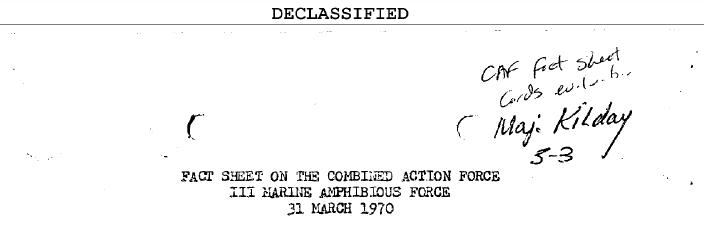
CAP
Historical
Data

|
CAP |
The CAP Web Site is not the official web site of the CAP Veterans Association. Any opinions expressed herein are strictly those of the Web Site creator, Tim "CAPVet"Duffie, and the respective contributors.
This initial page presents a historical perspective of the Combined Action Platoon Program and its place in the Military/Political history of the Vietnam War. These articles are reproduced simply as a matter of historical record. Much has been written about the effectiveness of the CAP program. However, a conclusion is beyond the scope of this Web Site, or me, for that matter. We will trust the reader to formulate his/her own opinion.
For the sake of simplicity, click on each link to visit the page.
Tim "CAPVet" Duffie
Editor, CAP Web Site
2nd LT Katie Johnson's Marine Corps Gazette Article, 2009
2nd LT Katie Johnson's Masters Thesis, 2009
NOTE: as of November, 2009, having graduated "31st in my class of almost 300 on Nov 5", 2nd Lt. Johnson is in Pesacola, FL, awaiting her Flight Training. CAP Marines are pleased at having been a small part in her success.
Tim,
Several years ago I contacted the Marine Corps History and Museum Division in Quantico, VA, and asked them to send me info about the Combined Action Program. They sent me the Vietnam War CD #8. On this CD was this attachment. It is titled:
Fact Sheet on the Combined Action Program
III Marine Amphibious Force
31 March 1970
I don't know if you have ever seen this but it is very interesting to read now what someone thought of the Combined Action Program in 1970. I hope you find it as interesting as I did.
Rick Schelberg
CAP 2-4-3, 1969
To View The Document, Click On Graphic Below

Pres. Lyndon B. Johnson's comments about CAP at the 1967 retirement of Gen. Wallace Greene, Commandant of the Marine Corps. His comments must be taken in context. At the insistence of Gen. Westmoreland, President Johnson had refused to further implement the CAP Program beyond the relatively small Marine Corps efforts. There were quite a few heated arguments between those involved. Arguments which, in essence, the Marine Corps lost.
Gen. Victor Krulak, First To Fight, Naval Institute Press, 1984, Chapter 12 (A New Kind Of War).
CAP Documentation:
Historical And Political
Perspectives
CAP Synopsis
The program involved the U.S. Marines in Vietnam. In theory, a Marine rifle squad and a medical Corpsman combined with a Vietnamese Popular Force platoon to provide continuous local security for villages in the tactical zone. The Marines lived in the villages, trained the local militia, and conducted patrols and ambushes, both day and night. Begun in August, 1965, with a single platoon, the program expanded as Marine volunteers were specially trained and organized into Combined Action Platoons. Squads from the platoons then combined with Vietnamese forces to form Combined Action Companies. By 1969, the number of platoons reached 102, organized into 19 companies under four Combined Action Groups, numbered 1st through 4th.
Taken from the "Bibliography" linked below.
A presentation by James DuGuid, Founder and (then) Director of the CAP Unit Veterans Association. This presentation was at the VA Phase III Symposium on the Treatment of Vietnam Veterans, Las Vegas, NV, 1985.
Combined Action Program Background And Reviews:
In 1966, Secretary of Defense Robert McNamara offered the following evaluation of the situation in Vietnam:
Success in pacification depends on the interrelated functions of providing physical security, destroying the VC apparatus, motivating the people to cooperate and establishing responsive local government.
Select Articles:
From an unknown issue of the Marine Corps Gazette, this is the story of Sgt. Ole Jessen-Klixbull and his CAC unit in Ky Khuong Village.
Francis J. West has written several articles/books about the CAP Program. The following was an early article about "Fort Page". From the October, 1967, issue of the Marine Corps Gazette
The following is a must read to understand the philosophy behind the Combined Action Platoon program. It is reproduced from a March, 1968, issue of the Marine Corps Gazette.
The ramifications of the Combined Action Company concept touches on the potential uses for both our military and the armed forces of other nations as vehicles for the development of societies, not their destruction.
Command Post:
Select articles by former US Marine Corps Officers and COs of the CAP Program.
Return To: